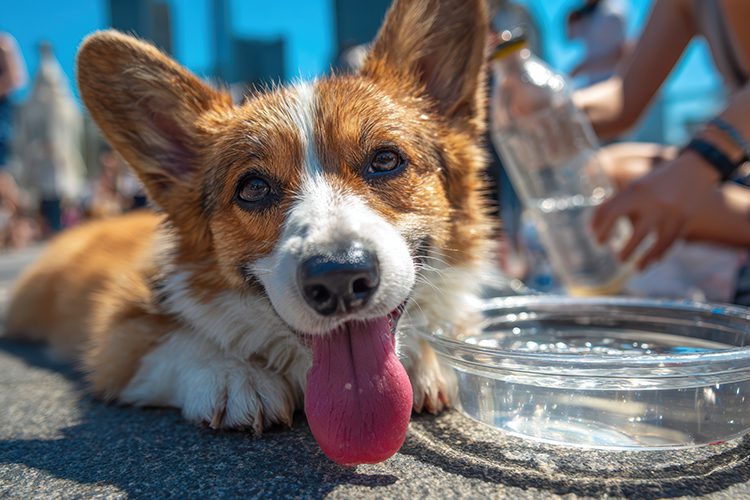Sunshine and desert landscapes are part of everyday life in Fort Mohave, but they can pose hidden risks for pets. When the temperatures climb, many pet owners ask, “Can dogs get sunburnt?” The answer is yes, and it’s more common than you might think. Dogs have sensitive skin under their coats, and just like people, they can suffer the effects of too much sun exposure. Understanding how sunburn affects dogs, what signs to look for, and how to minimize risk can help you protect your pet’s skin during outdoor adventures. If you ever have concerns about your pet’s skin or sun exposure, call Advanced Animal Care at 928-770-4918 or request an appointment.

How Dogs Can Get Sunburnt
Even though dogs have fur, it doesn’t provide complete protection from UV rays. Certain areas of a dog’s body like the nose, ears, belly, and groin have thinner hair or none at all, making them more vulnerable to sunburn.
Dogs with Less Fur Are More at Risk
Short-haired and light-colored breeds are especially susceptible. Breeds like Dalmatians, Boxers, Pit Bulls, and Greyhounds often have thin coats or exposed skin, which makes UV damage more likely. Dogs that have been shaved, have hair loss from allergies or illness, or have naturally pink skin are also more prone to sunburn.
Common Sunburn Hotspots
The most commonly affected areas include:
- Nose and muzzle
- Ear tips
- Around the eyes
- Belly and groin area
- Any shaved or hairless patches
These areas are either hairless or poorly protected by fur, making them targets for UV radiation, especially when dogs lie on their backs or spend extended time outdoors.
Signs Your Dog May Have a Sunburn
Spotting a sunburn early helps reduce discomfort and prevent further damage. Sunburn in dogs doesn’t always look exactly like it does in humans, but there are overlapping signs to watch for.
Visible Symptoms of Sunburn in Dogs
- Red, inflamed skin
- Dry or cracked skin
- Whining or flinching when touched
- Itching or constant licking of one area
- Blistering or scabbing in more severe cases
Sunburn typically appears a few hours after sun exposure. If your dog shows signs of pain, becomes lethargic, or experiences severe peeling or skin damage, prompt veterinary care is necessary.
Risks of Repeated Sun Exposure
The occasional sunburn may seem minor, but chronic UV exposure can lead to more serious problems over time.
Long-Term Skin Damage
Repeated sunburns can cause long-term changes in skin texture and pigment. Just like in people, prolonged exposure to UV rays may increase the risk of skin growths or cancer in dogs, particularly on the nose, belly, and ears.
Increased Sensitivity Over Time
Once your dog’s skin has been damaged by sunburn, it may become more sensitive. This means future burns can occur more easily, and skin irritation may persist longer. Dogs with existing dermatological conditions or allergies may also develop secondary skin infections if sunburned areas are scratched or licked excessively.
What You Can Do to Prevent Sunburn in Dogs
Living in Fort Mohave means plenty of sunny days, so prevention is especially important. A few simple steps can help reduce your dog’s risk of sunburn during walks, hikes, and backyard time.
Limit Outdoor Time During Peak Hours
The sun is strongest between 10 a.m. and 4 p.m. During this window, try to walk your dog early in the morning or later in the evening. Provide access to shade if your dog must be outside during midday hours.
Use Pet-Safe Sunscreen
Not all sunscreens are safe for dogs. Avoid products containing zinc oxide or PABA, which are toxic if ingested. Instead, ask your veterinarian for a pet-safe sunscreen that can be applied to vulnerable areas such as the nose, ears, and belly. Reapply as directed, especially after swimming or sweating.
Dress for Protection
Some dogs tolerate lightweight sun shirts, vests, or hats made for UV protection. These can shield sensitive areas from direct sunlight. Dogs with hair loss or healing skin may benefit from wearing these during outdoor activities.
Breeds That Require Extra Sun Protection
Certain dog breeds are naturally more vulnerable to sun damage and need extra care when spending time outside.
Short-Haired and Light-Colored Breeds
- Whippets and Greyhounds: Thin coats and lean builds provide little UV protection.
- Bull Terriers and Dalmatians: Light or pink skin increases risk of sunburn and irritation.
- Boxers and American Pit Bull Terriers: Low fur density leaves the skin exposed on the face, ears, and torso.
Dogs Prone to Skin Conditions
Dogs with allergies, autoimmune skin diseases, or recent surgeries may have exposed or sensitive skin. These dogs should be monitored closely and kept indoors during the sunniest parts of the day.
What to Do If You Suspect Sunburn
If your dog shows signs of a mild sunburn, reduce their sun exposure right away. Move them to a cool, shaded area and call Advanced Animal Care at 928-770-4918 for guidance on what steps to take next. Never apply human products or ointments unless directed by your veterinarian, as some may be harmful to dogs. Avoid home remedies and monitor your dog for signs of worsening skin damage. For severe cases, a veterinary visit to Advanced Animal Care is strongly recommended to evaluate the skin and provide appropriate care.
Living Safely in the Sun with Your Dog
So, can dogs get sunburnt? Yes, and in sunny places like Fort Mohave, it’s something pet parents need to stay ahead of. Protecting your dog’s skin from UV rays is part of helping them stay happy and healthy outdoors. Be mindful of sun exposure and know how to reduce the risk. If you have questions about sun safety or notice signs of irritation or redness on your dog’s skin, call Advanced Animal Care at 928-770-4918 or request an appointment online. Our team can help you take the best possible care of your pet in every season.
